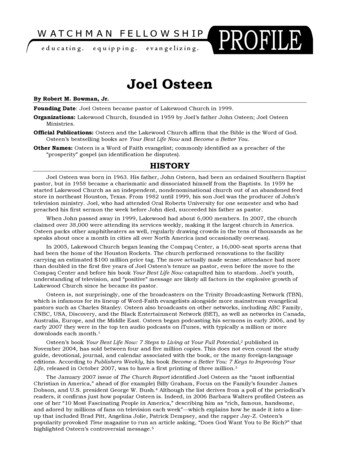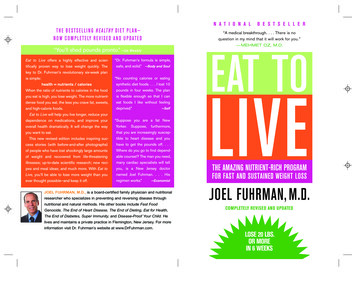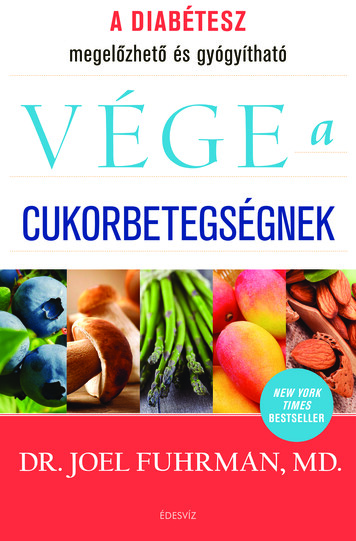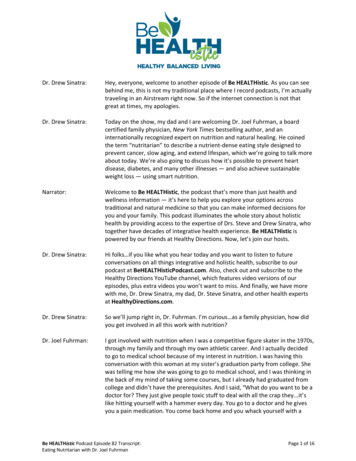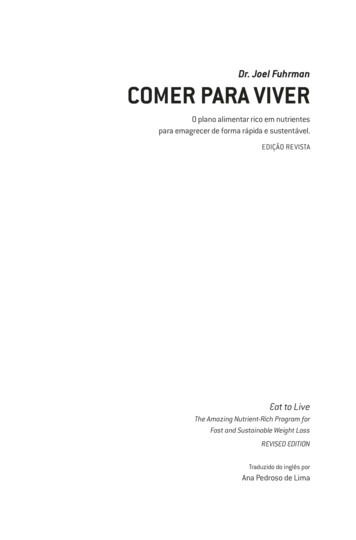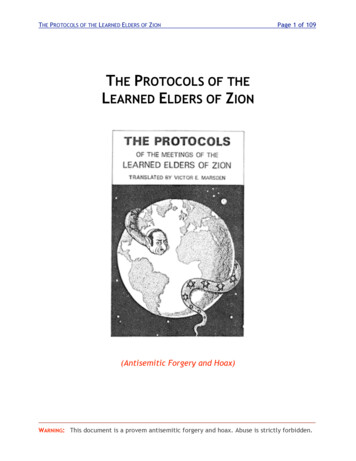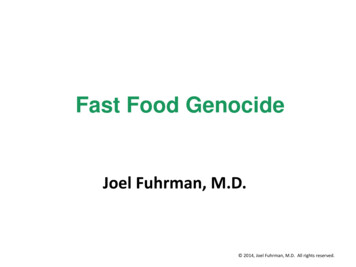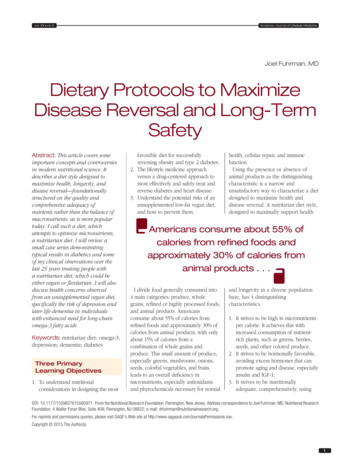
Transcription
580971American Journal of Lifestyle MedicineAmerican Journal of Lifestyle Medicinevol. XX no XAmerican Journal of Lifestyle MedicineJoel Fuhrman, MDDietary Protocols to MaximizeDisease Reversal and Long-TermSafetyAbstract: This article covers someimportant concepts and controversiesin modern nutritional science. Itdescribes a diet style designed tomaximize health, longevity, anddisease reversal—foundationallystructured on the quality andcomprehensive adequacy ofnutrients rather than the balance ofmacronutrients, as is more populartoday. I call such a diet, whichattempts to optimize micronutrients,a nutritarian diet. I will review asmall case series demonstratingtypical results in diabetics and someof my clinical observations over thelast 25 years treating people witha nutritarian diet, which could beeither vegan or flexitarian. I will alsodiscuss health concerns observedfrom an unsupplemented vegan diet,specifically the risk of depression andlater life dementia in individualswith enhanced need for long-chainomega-3 fatty acids.Keywords: nutritarian diet; omega-3;depression; dementia; diabetesThree PrimaryLearning Objectives1. To understand nutritionalconsiderations in designing the mostfavorable diet for successfullyreversing obesity and type 2 diabetes.2. The lifestyle medicine approachversus a drug-centered approach tomost effectively and safely treat andreverse diabetes and heart disease.3. Understand the potential risks of anunsupplemented low-fat vegan diet,and how to prevent them.health, cellular repair, and immunefunction.Using the presence or absence ofanimal products as the distinguishingcharacteristic is a narrow andunsatisfactory way to characterize a dietdesigned to maximize health anddisease reversal. A nutritarian diet style,designed to maximally support healthAmericans consume about 55% ofcalories from refined foods andapproximately 30% of calories fromanimal products . . .I divide food generally consumed into4 main categories: produce, wholegrains, refined or highly processed foods,and animal products. Americansconsume about 55% of calories fromrefined foods and approximately 30% ofcalories from animal products, with onlyabout 15% of calories from acombination of whole grains andproduce. This small amount of produce,especially greens, mushrooms, onions,seeds, colorful vegetables, and fruits,leads to an overall deficiency inmicronutrients, especially antioxidantsand phytochemicals necessary for normaland longevity in a diverse populationbase, has 4 distinguishingcharacteristics.1. It strives to be high in micronutrientsper calorie. It achieves this withincreased consumption of nutrientrich plants, such as greens, berries,seeds, and other colored produce.2. It strives to be hormonally favorable,avoiding excess hormones that canpromote aging and disease, especiallyinsulin and IGF-1.3. It strives to be nutritionallyadequate, comprehensively, usingDOI: 10.1177/1559827615580971. From the Nutritional Research Foundation, Flemington, New Jersey. Address correspondence to Joel Fuhrman, MD, Nutritional ResearchFoundation, 4 Walter Foran Blvd, Suite 409, Flemington, NJ 08822; e-mail: drfuhrman@nutritionalresearch.org.For reprints and permissions queries, please visit SAGE’s Web site at yright 2015 The Author(s)1
Mon Mon XXXXAmerican Journal of Lifestyle Medicinesupplements when necessary toassure optimal levels of vitamin D,vitamin B12, iodine, zinc,eicosapentaenoic acid (EPA), anddocosahexaenoic acid (DHA), basedon dietary history, and whenavailable, blood work.4. It strives to avoid food containingtoxins, contamination, and infectiousagents.It is well established that modestmicronutrient insufficiency is ubiquitousand can lead to DNA damage,mitochondrial decay, and telomeredecay. If we classify phytochemicals as aform of micronutrients, because of theirrelation to immune function, diseaseprotection, and longevity, then we mustclassify almost all Americans (bothvegetarians and meatatarians) asmicronutrient deficient, especiallyregarding micronutrients derived fromgreen vegetables.1-10I present the equation H N/C toportray the basic principle that tomaximize healthy life expectancy (H)we have to eat a diet rich inmicronutrients (N) per calorie (C). MyANDI (Aggregate Nutrient DensityIndex) is a useful tool to help visualizethe high concentration ofmicronutrients in greens and othercolored produce compared with animalproducts and processed foods. Itutilizes over 30 separate nutritionalparameters to estimate a food’s overalllevel of micronutrients per calorie. Thishas been demonstrated to be effectivein increasing the sales and consumptionof nutrient-rich produce, in WholeFoods Market.However, this is not all you need toknow to devise a diet with maximalhealth benefits, because some foods withonly a moderate nutrient density havesalient features that make them valuablefor disease resistance. For example,mushrooms and flax seeds containpowerful anti–breast cancer components,not adequately appreciated in theiraggregate nutrient density score, andlikewise nuts, though calorie-dense, havecholesterol-lowering and othertherapeutic benefits.2Table 1.Glycemic Load of Common Foods28.FoodGlycemic LoadFoodGlycemic LoadWhite potato29Rolled oats13White rice26Whole wheat11White pasta21Mango11Chocolate cake20Lentils9Corn18Apples9Sweet potato14Kiwi8Grapes14Green peas8Hormonal Favorability:Insulin and Insulin-LikeGrowth Factor-1 (IGF-1)Furthermore, we have to consider thesecond principle of a nutritarian diet—hormonal favorability. It has becomeincreasingly evident that higher levels ofIGF-1 are linked to increased early lifemortality, higher incidence of cancer, andpremature aging, including aging of thebrain.11-14 It is also well established thatdiets with excessive amount of animalprotein elevate IGF-1, and that optimallylow levels are not achieved until asignificant reduction in animal productsis maintained in the diet. However, theexact percentage of calories or amountof animal products below which wouldoptimize IGF-1, and whether a higherIGF-1 might be more favorable in theelderly, is yet to be determined.15-17 Moredetails about various protein sources andvarying animal protein and plant proteinintake to achieve favorable IGF-1 in alldecades of life is not the topic of thispresentation. However, studiesdemonstrate that with more than 5% to10% of calories from animal productsIGF-1 can rise significantly.18There is also an overwhelming amountof evidence that excessive production ofinsulin in response to high glycemicfoods is disease-promoting andlifespan-shortening. Elevated insulindoes not merely increase risk ofdiabetes and heart disease but haspro-angiogenic and cancer-promotingeffects.19-23 For example, in a metaanalysis of 39 studies, a high glycemicload was associated with increased riskof colorectal and endometrial cancers,21and a meta-analysis of 10 prospectivestudies demonstrated a link betweenhigher glycemic load and breastcancer.24,25 Another study demonstratedfor every 100 grams of white riceconsumed per day, breast cancer riskincreased 19%, whereas the sameamount of whole grain, brown rice, orbeans had almost the direct oppositeeffect.26High glycemic processed foods are sodisease-causing, recent research suggeststheir promotion of heart disease is evenmore powerful than saturated fats fromanimal products, a chilling concernconsidering all the white bread, whiterice, and white potato productsconsumed by populations around theworld and in this country.27 Table 1provides the glycemic load of commonfoods.Consider white potatoes as an exampleof a high glycemic carbohydrate, with afavorable caloric density. The Nurses’Health Study demonstrated an 18%increased risk of diabetes for each potatoeaten daily by overweight women.Notably, the glycemic load of potatoesrather than the added or associatedbutter or oil was implicated.29
vol. XX no XAmerican Journal of Lifestyle MedicineTable 2.Starch and Fiber Fractions in Selected Food.28Resistant Starch (%)Resistant Starch Fiber (%)13Black beans2770Navy beans2662Lentils2559Split peas2558Corn2545Brown rice1520Rolled oats717Whole wheat flour214Pasta39Potato35Ominously, data from the North CarolinaColon Cancer Study, with more than1000 cases of colon cancer comparedagainst more than 1000 controls,demonstrated a more than 50% increasedrisk of rectal cancer in those eating 3potatoes a week compared to thoseeating 1 potato a week, and more thanan 80% increase comparing 5.6 servingsa week to 1 serving.30 Quite shockingfindings, but note these heightened riskswere only observed for non–wholegrains and potatoes, and not fordiscretionary fat suggesting theassociation is demonstrating significantglycemic risk, and not merely anassociation with a dietary pattern or fattytoppings used on a potato. When weobserve the association with disease riskbecomes more pronounced as bodyweight and insulin resistance increases, itspecifically identifies the potato’sglycemic effect, which becomes a moresignificant stimulator of excess insulinrelease as a person’s body weightincreases. And because of the fatpromoting effects of insulin, highglycemic foods can make it more difficultfor the overweight to lose weight.31This information becomes clinicallyrelevant when treating overweightdiabetics, as meat, sweets, and highglycemic carbohydrates promoteunfavorable hormonal influences. We canclassify carbohydrate-rich foods on ahierarchal scale based on their nutrientlevels, fiber content, and amount ofresistant starch. As the amount of fiberand resistant starch increase (see Table 2),more dramatic benefits for the overweightand/or diabetic are noted. Resistant starchis counted as calories on labels andcharts, but during digestion, 90% ofresistant starch calories are lost, thusacting more like a type of fiber.BeansBy considering this hierarchal scale ofcarbohydrate quality, we can utilize thisinformation to devise a dietary protocolthat reduces exposure to the highestglycemic carbohydrates and incorporatesmore beans, more raw and cookedgreens with other low glycemicvegetables, and more nuts and seeds toachieve dramatic glucose favorablebenefits for the diabetic, prediabetic, orthose with metabolic syndrome. As anexample, a 2-group controlled trialencouraged one arm to increase legumeintake by 1 cup a day, and then anotherarm to increase their intake of wholegrains by the same amount. A clearbenefit occurred for adding more wholegrain, but more dramatic benefitsoccurred for the addition of beans fromindividual baseline (Table 3).32Beans are not merely glycemicallyfavorable themselves, but theirfermentation and prebiotic effects lowerthe glucose absorption from other foodsin the diet. These glucose-loweringbenefits occur not merely in the mealeaten with the beans but later as wellwhen no beans are eaten. This has beencalled the “second-meal effect.”33-35 Beanshave multiple benefits for favorableglycemic response, weight reduction, andanticancer effects. Across a broadspectrum of different regions andethnicities, beans/legumes were found tobe the most consistent and reliablepredictor of longevity. An 8% reductionin death was reported for every 20 grams(2 tablespoons) of beans eaten daily.36There are numerous anticancercompounds in beans, nuts, and seeds,including phytic acid and inositolpentakisphosphate, which have beenshown in animal studies to inhibit tumorgrowth, migration, and invasion, and alsoaugment NK (natural killer) cellactivity.37-39Nuts and Seeds:Therapeutic Efficacyin Disease ReversalIncluding more calories from nuts andseeds enables one to reduce glycemiccalories, further increasing therapeuticpotential, leading to further reductions inHbA1c and lipids.40 Observational studieson this topic demonstrate that those whoconsume nuts regularly tend to have alower body mass index (BMI) thannonconsumers and more weight losscompared to equal calories ofcarbohydrate in the diet.41-43Interventional studies corroborate thesefindings. For example, a studydemonstrated a 62% greater reduction inBMI and 50% more waist circumferencereduction in the group given nuts insteadof more carbohydrate.43,44 The mainproperties of nuts that contribute to3
Mon Mon XXXXAmerican Journal of Lifestyle MedicineTable 3.Changes From Baseline Between Whole Grain and Bean Groups33.GroupsWhole GrainBeanFiber increase (g/1000 calories)1.910.0Glycemic load reduction 5 48HbA1c (%) 0.03 0.5Body weight (lb) 4.4 5.7Fasting glucose (mg/dL) 7 9Triglycerides (mg/dL) 9 21Cholesterol (mg/dL) 2 9Systolic blood pressure (mm Hg)0 4Diastolic blood pressure (mm Hg)0 3weight maintenance are high satiety,increased oxidation of fat, and all of theircalories are not accessible for absorption(15% to 20%), increasing stool fat.41-43The idea that there is some health ortherapeutic advantage of extreme fatrestriction by excluding seeds and nutsfor lowering weight, improving diabeticparameters, or reversing heart disease isnot supported by the preponderance ofevidence today. Nuts and seeds alsoeffectively lower low-density lipoprotein(LDL) cholesterol. A pooled analysis of24 (3-8 weeks) interventional trialsconfirmed an average of 4.9% LDLreduction for 1.5 ounces nuts/day, and a7.4% reduction for 2.4 ounces.45 And it isnot merely risk factor measurements; theuse of nuts and seeds is associated witha reduced risk of cardiovascular eventsand overall mortality. The best andlargest cohort studies in nutritionalepidemiology, such as the AdventistHealth Study, the Iowa Women’s HealthStudy, the Nurses’ Health Study, thePhysicians’ Health Study, and the CAREStudy all confirm that eating nuts and/orseeds is associated with a 30% to 50%decreased risk of coronary artery disease(CAD) death, primarily sudden cardiacdeath, and dramatic increases in all-cause4mortality. For example, in the PhysiciansHealth Study, which followed 21 454male physicians for 17 years, the mostdramatic relationship between any foodand survival was the reduced mortalityassociated with nut consumption 2 ormore times per week (compared to nonuts or seeds). In this study, nuts andseeds had antiarrhythmic and antiseizureeffects—associated with a 60% reductionin sudden cardiac death.46 These benefitsare not limited to meat-eatingpopulations; significant lifespan benefitsare seen in nut-eating vegans as well. Inthe oldest Adventists (over 84), a 39%decrease in coronary heart disease deathwas demonstrated comparing those withhigher (5 times weekly) to low nut and/or seed intake.47,48The Adventist Health Study confirmedthat the consumption of nuts was one ofthe most dramatic features, accountingfor extended lifespan benefits, avariable producing a greater benefitthan vegan status. The graph on the lifeexpectancy in Adventist men isreproduced in Figure 1.49 Each column isdisplayed as expected age at death at lowand high risk, assuming medium risk forall columns to the right, and the samerisk (low or high) for all columns to theleft. For example, for nuts, Adventistswho are vegetarian, exercise regularly,and eat 5 servings of nuts/week can beexpected to live to age 87, assumingmedium-range risk values for BMI andsmoking. Adventists who are notvegetarian, do not exercise regularly, anddo not eat nuts regularly would beexpected to live to age 79.2. These datasuggest that these variables cumulativelyadd 7.8 years of life expectancy. Nutsalone account for a 5.6 variance inlifespan in the Adventist Health Studydata.47 These data also mean thatflexitarians who ate nuts and seedsgenerally lived longer than vegans, whoexcluded them.Multiple potential mechanisms exist forthese dramatic lifespan benefits of nutsand seeds, including the effects ofpolyphenols, sterols, vitamin Efragments, nitric oxide promoters, cancerinhibitors, and enhanced micronutrientabsorption of phytonutrients from otherfoods (from having nuts and seeds in themeal). In the past 25 years of my treatingthousands of patients with high bloodpressure, diabetes, and advanced heartdisease, I have observed dramatic resultsutilizing these principles. Excluding nutsand seeds in favor of more low- ormid-quality carbohydrates is undoubtedlyunfavorable for those medically ormetabolically challenged with chronicdisease, and would presumably increasemortality risk. For maximum benefitsthey should be incorporated into mealsrather than being used as a snack. If arare individual uses them excessively,and not for replacement calories, thentheir use would need to be curtailed.Walnuts, hemp seeds, chia seeds, andflax seeds are those nuts and seeds withthe most favorable omega-3 content.Walnuts, in particular, have beenassociated with enhanced cholesterolefflux, increased vessel elasticity andendothelial function, decreased LDL andtriglycerides, increased high-densitylipoprotein, lower particle number, lowerserum glucose, reduced oxidant load onbrain cells, and improved interneuronalsignaling and neurogenesis.50,51 They area valuable part of a dietary protocoldesigned to reverse heart disease.
vol. XX no XAmerican Journal of Lifestyle MedicineFigure 1.Expected Ages at Death (95% Confidence Intervals) in Men With Jointly High- orLow-Risk Values for the Risk Factor in a Particular Column and Those to Its Left(Other Variables at Medium-Risk Values).BMI, body mass index.Source: Fraser and Shavlik.49Lightening the AbsorptiveRate of Calories Intothe BloodstreamThe glycemic index or load considersthe rate at which glucose builds up inthe bloodstream over time. The morerapid and concentrated the elevation ofglucose in the blood, the more significantthe risk. The same can be said of fatentering the blood quickly (Figure 2).Whereas oils and even concentratedanimal fats can enter the bloodstreamrapidly, the fat content of seeds and nutsis absorbed over several hours, allowingthe calories to be burned for energyrather than stored as fat, which can delayhunger and more effectively reducecalorie demand signaling.I propose that the vast majority ofinformed nutritional scientists andphysicians who have no predeterminedagenda or bias, after reviewing thepreponderance of evidence on theseissues, would be forced to agree on thefollowing 3 dietary principles:1. Vegetables, beans, seeds, nuts, fruits,are good for you.2. Excessive amounts of animal productsincrease chronic disease risk.3. Refined carbohydrates promotechronic disease and lead tooverweight and obesity.Consuming more greens, mushrooms,onions, tomatoes, beans, nuts, andseeds, to replace lower qualitycarbohydrates, results in a dramaticlowering of glycemic load and diabeticand cardiovascular parameters. Forexample, in a trial of 117 diabeticsrandomized to eat an equal caloricamount of nuts daily, or muffins or both,the nut group showed dramaticimprovement in both glycemic controland serum lipids, including improvementin apoproteins.40 Utilizing these dietaryprinciples, we conducted a small pilotstudy of 11 poorly controlled diabetics,resulting in them earning nondiabeticparameters after following this portfolioof dietary recommendations for a meanof 7 months.52 Of note was the 27-pointreduction in systolic blood pressure,while blood pressure medications werelowered by more than 50%. Plus, thoseremaining on blood pressuremedications, and the one person still lefton metformin, were only onmedications, because their primaryphysicians did not taper and discontinueappropriately in accordance with recentguidelines for medication use. Theaggressiveness of this dietary approachenables patients to reduce andeventually eliminate dependence ondiabetic medications, blood pressuremedications, and statin drugs. Theelimination of medication then furtherimproves the results and sustainability,as many medications in use todaycontribute to metabolic derangementand lead to weight gain. The mostmetabolically unfavorable medicationsinclude insulin, sulfonylureas,β-blockers, and statins. For example, onFebruary 6, 2008, the National Heart,Lung, and Blood Institute stopped theACCORD Study (Action to ControlCardiovascular Risk in Diabetes) as theresults showed that intensive treatmentof diabetics to better control their fastingglucose increased the risk of dyingcompared to those patients treated lessaggressively.53 This demonstrated theharm of increasing dependence onmedications, which cause weight gain asthey drive the failing β-cells to produceinsulin, with the goal to reduce glucose.Getting better short-term glucosenumbers results in more β-cell deathand more insulin resistance leading tolong-term enhanced morbidity andmortality.A Nutritarian DietFeatures Large green salads with seed-nutbased dressings5
Mon Mon XXXXAmerican Journal of Lifestyle MedicineFigure 2.Speed of Absorption of Calories in Fast Food Versus Slow Food.Preventing Dementiaand Preventing andTreating DepressionSource: Unpublished data. Bean soups with carrot/tomato juiceand cruciferous vegetables Steamed or wokked green vegetables,onions, and mushrooms Animal products limited to 0 to 3small servings per week No dairy, white flour, white rice Remove all processed foods, coldcereals, and sweets No sweeteners, except fruit andlimited unsulfured dried fruit Carbohydrate with high nutritionalquality such as peas, squashes, lentils,and intact whole grains Use of protective foods, such aswalnuts, mushrooms, onions, berries,and seedsWeight Loss andCardiovascular BenefitsThat Are PermanentI have observed for more than 20 yearsthat a diet designed around natural plantfoods with the liberal use of greens, nuts,and beans has resulted in long-termsustained weight loss in thousands ofoverweight individuals. We surveyed 768of these people and tracked a reductionin their caloric drive and addictivesensations that drove overeating behaviorin their past.54 Those most adherent tothe program had the most modifiedreduction in hunger. The interestingfinding was that it took a significant time(4-6 months) before their foodpreferences changed, but the majoritybecame satisfied with the enjoyment oftheir new eating style compared to their6A recent survey of individuals followinga nutritarian diet for multiple years gavethe following uncorroborated, selfreported results for weight loss. HIPPAcompliant chart review is presently inprocess by researchers to corroborate thedata. Although this data is not ready forpeer-review publication, the resultsspeak loudly about the efficacy of thisapproach (Figure 3).prior standard diet. It became theirpermanently adopted lifestyle not ashort-term diet (Table 4).The potential of this program to reverseadvanced heart disease and diabetes isalso demonstrated not merely by thethousands of clinical disease reversalsbut by looking at some case histories ofthe most severely ill individuals. A goodexample is Ronnie from Texas, who hadre-occlusion and chest pain 4 years aftercoronary artery bypass surgery (Table 5).He then underwent triple angioplasty,only to experience restenosis within afew months, leaving him homebound.Ronnie has been totally free of heartdisease and all medication use since.Similarly, Julia from New Jersey had 5angioplasty procedures in 3 years and 3heart attacks in a 3-month period leavingher a cardiac cripple in a wheelchair. Shewas unable to care for herself, and shewas on 10 medications for her heart andhigh blood pressure. She lost 105 poundswithin a year and requires nomedications. Today, she dances, shops,takes exercise class, gardens, and has anormal life. The reversal from advancedcoronary occasions include patients whopresented with unstable angina (at rest)refusing surgical and proceduralinterventions that still made completerecoveries in a relatively rapid amount oftime. Some of these cases with advancedCAD are people who have beenfollowed by me for more than 20 years,who are now into their 90s, with noreoccurrence of CAD. None of themexcluded nuts or seeds.An important concern with following alow-fat vegan diet for therapeuticbenefits is the potential for risk ofdepression and dementia from fatty aciddeficiency, especially from chronicallylow EPA and DHA. More than a dozenepidemiological studies have reportedthat reduced levels of long-chainomega-3 fatty acids are associated withincreased risk for age-related cognitivedecline or dementia such as Alzheimer’sdisease.55-58 DHA promotes neurogenesisand improved cognition. Not only doesDHA, in animal models, prevent amyloidaccumulation, but clinical trials showincreased brain shrinkage with aging inthose with lower blood levels of DHAevaluated 8 years later after DHAmeasurements.59 The hippocampus areaplays an important role in memory andusually begins to atrophy beforesymptoms of Alzheimer’s appears, andwas particularly vulnerable to thisshrinkage associated with low omega-3index (3.4% compared to 7.5%).This is particularly concerningconsidering the large number ofunsupplemented vegans that demonstratedeficiency as measured by the DHA–EPAomega-3 index (Figure 4).60 In this study,166 healthy vegans showed a wide rangein DHA–EPA index, which did notcorrelate with the amount of short-chainomega-3 intake. That means more ALAfrom flax seeds and walnuts did nottranslate into higher levels of EPA andDHA, suggesting that the major variationwas primarily due to genetic differencesin conversion enzymes. A significantpercentage had levels below 3,
vol. XX no XAmerican Journal of Lifestyle MedicineTable 4.Changes From Baseline in High Nutrient Density Diet.53BaselineHND Diet101BMI34.426.8HbA1c (%)8.155.8Systolic blood pressure (mm Hg)148121Triglycerides (mg/dL)171103Number taking diabetic medicationsAbbreviations: HND, high nutrient diet; BMI, body mass index.Table 5.Nutritarian Diet Case Study: Ronnie From Texas.July 2008aJuly 2009 (No Medications) 300160160/110115/705833Total cholesterol8.155.8Triglycerides (mg/dL)31263LDL (mg/dL)14875Body weightBlood pressureWaist circumference (in.)Abbreviation: LDL, low-density lipoprotein.aOn metoprolol 200, irbesartan 300, atorvastatin 20.suggesting serious risk of later life braincompromise.Omega-3 Index in VegansMy more than 20 years of clinicalexperience treating vegans who havesome failure to thrive on a vegan diet hasrepeatedly demonstrated a proportionwhose lack of DHA and EPA resulted inan episode of depression or anxiolyticdepression. These findings are consistentwith a meta-analysis demonstratingpatients with depression commonly havelower EPA and DHA levels.61-63 DHAdeficiencies in depressed patients relativeto healthy controls is consistent withimpaired peroxisome function linked toanxiety and depression, and the lowomega-3 fatty acid status commonlyobserved in patients with MDD (majordepressive disorder) may reduce theeffectiveness of selective serotoninreuptake inhibitors (SSRIs).64,65Low 25(OH)D levels can alsoexacerbate these risks of dementia anddepression and have been associatedwith diminished global cognitive functionand greater decline over a 4-year period.In this study, those with 25(OH)D above30 ng/mL showed insignificant decline,20 to 29 moderate decline, and below 20severe decline.66 These findings werematched almost perfectly in a morerecent study as well.67 It is important topay attention to all of these factors(because of the varied needs ofindividuals) to assure those counting onour dietary advice are not left with someirreversible loss of memory and brainfunction. I see many patients eatinghealthfully, following the advice ofleaders in this community, with thisconstellation of risks.Zinc levels and needs can also varyamong individuals with some peoplerequiring more than is biologicallyaccessible through a vegan diet. Ameta-analysis of 17 studies measuringzinc levels demonstrated zincconcentration averaged 1.85 µmol/Llower in depressed subjects versuscontrols, and greater depression severitywas associated with greater relative zincdeficiency.68 The research alsocorroborates my clinical experience thatwomen are more susceptible todepression from low and borderline zincintake compared to men.69 I have foundthat supplemental zinc added to theantidepression protocol has beenextremely effective, especially inspeeding up the response to therapy andameliorating anxiety associated with thedepression or anxiolytic depression.Some studies do corroborate thisexperience.70,71My protocol to treat depressedindividuals includes the following:1.2.3.4.5.Morning light therapyZinc supplementationSaffronExerciseEPA and DHA from fish oil or algae(vegan source)6. A nutritarian diet (high vegetableintake), including avoidance ofrefined and high glycemiccarbohydratesSince many of these treated patientswere relatively SSRI-resistant, using theextra zinc and EPA and DHA becamelifesaving for them. The sensitivity toSSRI-resistant and partially resistantpatients to long-chain omega-3 has alsobeen noted in clinical trials.72 This studydemonstrated symptom remission in 40%of those treated with low-dose fish oilsand 100% symptom remission using7
Mon Mon XXXXAmerican Journal of Lifestyle MedicineFigure 3.Self-Reported Average Weight Loss Following a 2-Year Nutritarian Diet.Source: Unpublished data.Figure 4.Omega-3 Index in Vegans.Source: Sarter et al.60high-dose fish oils among SSRI-resistantadolescents, although the study only had7 people in each group. Nevertheless, itis consistent with what I have observedin my practice hundreds of times overthe past 25 years.8Understanding Failureto Thrive in a SmallPercentage of VegansA number of critical trials haveconfirmed the benefits of dietarysupplementation with omega-3 fattyacids not only in several psychiatricconditions but also in inflammatory,autoimmune, and neurodegenerativediseases. Unique to my clinicalexperience is observing severelydeficient levels of DHA (testing almostzero) on a small number of long-termvegans and near vegans who developedParkinson’s disease. It is possible thatthis long-standing severe omega-3deficiency sensitized their brain cells tosom
Joel Fuhrman, MD Abstract: This article covers some important concepts and controversies in modern nutritional science. It describes a diet style designed to maximize health, longevity, and disease reversal—foundationally structured on the quality and comprehensive adequacy of nutrients
